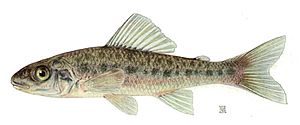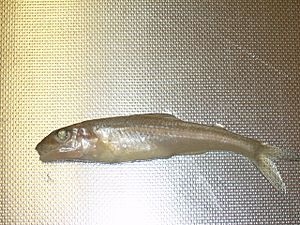Trout-perch facts for kids
Quick facts for kids Percopsis omiscomaycus |
|
|---|---|
 |
|
| Conservation status | |
| Scientific classification | |
| Kingdom: | |
| Phylum: | |
| Class: | |
| Order: |
Percopsiformes
|
| Family: |
Percopsidae
|
| Genus: |
Percopsis
|
| Species: |
P. omiscomaycus
|
| Binomial name | |
| Percopsis omiscomaycus (Walbaum, 1792)
|
|
The trout-perch (Percopsis omiscomaycus) is a small freshwater fish. It is also known as the grounder or sand minnow. This fish is one of only two species in its family, Percopsidae.
Trout-perch prefer clear or slightly cloudy water. You might sometimes see them washed up on beaches. However, it's rare to spot them alive in the water. They live in rivers and lakes across North America.
Their name, 'trout-perch', comes from Greek words. Perc means perch and opsi means appearance. The species name omiscomaycus comes from a Native American word for 'trout'. This is because trout-perch look a bit like both trout and perch. They are an important food source for bigger fish. These include walleye, northern pike, and lake trout.
Trout-perch are generally small fish. They live in deep water during the day. At night, they move to shallower areas. People don't usually fish for them to eat. However, they are sometimes used as bait fish.
Contents
What Does a Trout-Perch Look Like?
Trout-perch can grow up to 20 centimeters (about 8 inches) long. Most are around 8.8 centimeters (about 3.5 inches). Males and females look the same.
They are silvery or almost clear in color. They have rows of dark spots along their sides. These spots are found along their lateral line and above it. A lateral line is a special line of sensors. Their fins are mostly clear.
These fish have thick bodies. They also have a long head, a long snout (nose), and a small mouth. They have one fin on their back (dorsal fin). This fin has 1 to 3 sharp spines and 10 to 11 soft rays. They also have a small, fleshy fin called an adipose fin. This fin is like the one found on trout. It helps tell them apart from similar fish. These include the yellow perch and the walleye. Their tail, or caudal fin, is forked.
Like most bony fish, trout-perch have thin, flexible scales. Their scales are called ctenoid scales. These are similar to the scales on a perch.
Where Do Trout-Perch Live?
Trout-perch are found all over North America. Their range stretches from Canada and Alaska down to the Potomac River in Virginia. They live in the Great Lakes. This means you can find them in Illinois, Indiana, Michigan, Minnesota, New York, Ohio, Pennsylvania, and Wisconsin.
They also live in the Mississippi River Basin. This area includes Iowa, Missouri, Kentucky, Tennessee, Arkansas, Mississippi, and Louisiana. They have also been seen in North Dakota, Montana, and West Virginia.
Trout-perch like clear or slightly cloudy water. They prefer areas with sandy and gravelly bottoms. They avoid shallow places with soft mud.
Daily Movements and Diet
Trout-perch make a daily journey. They travel from deep water during the day to shallow water at night. This is called diel vertical migration. This movement is important for their predators. It also helps move nutrients around in lakes. Moving at night helps them find food safely in the dark.
Trout-perch eat many small invertebrates. These include insect larvae and crustaceans. Young trout-perch eat tiny animals called zooplankton. Larger adult trout-perch will sometimes eat small fish, like the johnny darter.
Trout-Perch Reproduction and Life Cycle
Trout-perch become ready to reproduce when they are 1 to 3 years old. Their spawning season is from May through August. They lay their eggs on sandbars and rocks in lakes. They also use gravel or sand in small streams that flow into lakes.
During spawning, three or four males will gather around one female. They release their sperm as the female releases her eggs. The eggs are then fertilized and sink to the bottom. A single female can lay between 200 and 700 eggs. The parents do not care for the eggs after they are laid. The eggs hatch in about six days if the water temperature is between 20 and 23 degrees Celsius (68-73 degrees Fahrenheit). Trout-perch usually live for about 4 years.
The Role of Trout-Perch in Nature
Trout-perch are very common fish. However, scientists are still learning about their exact role in nature. It is believed they help keep their habitat balanced.
A study in Saginaw Bay, Lake Huron, looked at their role. One important finding was their high energy content. Trout-perch had more energy (4795 joules) than other similar fish. For example, yellow perch had 4662 joules and round gobies had 3740 joules. This high energy makes trout-perch an important food source for other animals.
The study also showed what trout-perch like to eat. They mostly feed on Chironomidae larvae (lake fly larvae). However, bigger trout-perch sometimes prefer to eat Amphipoda. Smaller trout-perch eat zooplankton. Lake flies, their larvae, and Amphipoda are key parts of their diet. This diet seems similar in other places too.
Trout-perch are important because they are a food source for many animals. They also eat other species. This helps keep the right number of different species in their environment.
Trout-Perch and Parasites
Trout-perch can be infected by a tiny organism called Myxobolus intramusculi. This is a type of protist that lives in their muscles. Scientists found that this parasite produces small spores. These spores are found mostly in the red and white muscle fibers of the fish. They are rarely found in the skin tissue.
The parasite grows inside the fish's muscle cells. However, it does not seem to harm the fish much. It does not usually damage the cell or kill the fish. Infected trout-perch usually appear healthy. They do not show muscle damage. The only clear sign of the parasite is a small lump (cyst) in the infected area. These parasites do not kill the trout-perch. Also, these parasites cannot spread from fish to humans.
See also
 In Spanish: Trucho-perca para niños
In Spanish: Trucho-perca para niños



